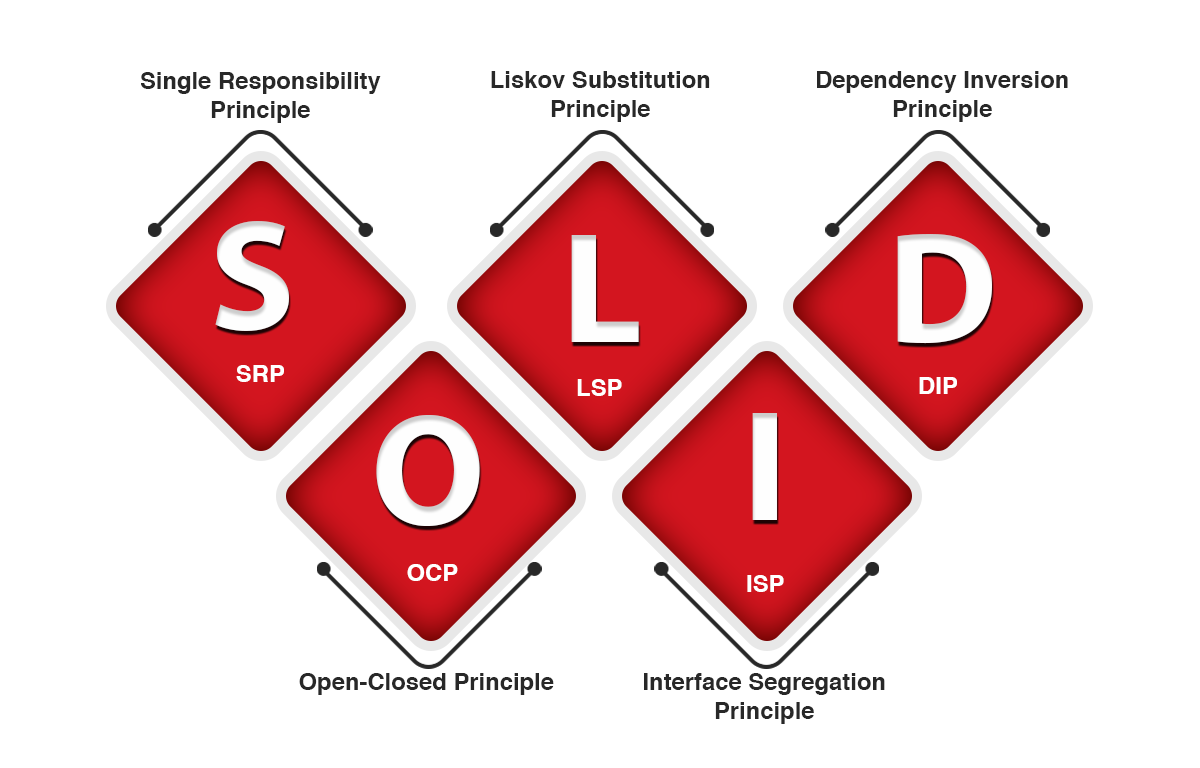Did you know that software maintenance typically accounts for over 50% of development costs? That's where SOLID comes in – five principles that streamline development, reduce bugs, and make your codebase more adaptable.
In this guide, we will unravel these principles one by one, with practical examples that resonate with both beginners and experienced developers. Get ready to revolutionize your coding approach, as we navigate the world of C#.NET and SOLID design. Let's build robust, efficient, and future-ready software together.
Solid Design in C# with Real Time- Example
In this series of articles on SOLID Design Principles in C#, I will delve into illustrative examples derived from real-world contexts involving diverse types of .NET applications, such as MVC, Web API, and Console Applications. The SOLID Design Principles in C# constitute a set of guiding principles adept at addressing a multitude of software design challenges. These principles serve to systematically alleviate the issue of tightly intertwined code within software components, thereby enhancing the comprehensibility, adaptability, and maintainability of software designs.
Do We Need to Know About SOLID Design Principles? And Why?
It's essential to recognize that change requests and new features are inherent to the software development process, making blame an inappropriate response. The crux of the matter lies within the application's design itself.
Acknowledging this challenge and aiming to aid students, novices, and seasoned professionals in acquiring swift proficiency in crafting robust software using the SOLID Design Principles within the C# programming language, I am embarking on a series of articles. These articles will illuminate SOLID Design Principles through tangible real-world instances, offering practical insights into their application
Basic Reasons Behind the Failure of Application
Several primary factors contribute to the lack of success in many applications:
Overloading Classes with Functionalities:
This pertains to the practice of incorporating numerous functionalities within a single class, even when these functionalities are not inherently relevant to the class's intended purpose.
Enforcing Strong Interdependence Between Software Components:
This refers to the implementation of tight coupling between distinct software components, specifically among classes. When classes exhibit interdependencies, modifications made to one class can exert a ripple effect on others, leading to unintended consequences and increased complexity.
How to Overcome this Situation?
Here are a few things that can help:
• Adhere to the appropriate architectural pattern (e.g., MVC, Layered, 3-Tier, MVP) in alignment with project requirements.
• Enforce design principles such as SOLID Principles and ONIO Design Principles throughout the development process.
• Select the relevant design patterns, including Creational Design Patterns, Structural Design Patterns, Behavioral Design Patterns, Dependency Injection Design Patterns, and Repository Design Patterns, based on the specific needs of the project.
Solid Design Principles
The SOLID Design Principles serve as invaluable tools for addressing the common software design challenges encountered in daily programming tasks. These principles have been rigorously tested and proven to enhance software designs, making them more comprehensible, adaptable, and maintainable. By following these principles during the application design phase, developers can create superior software applications.
SOLID Design Principles encompass five key principles, each contributing to the goal of enhancing software quality:
Single Responsibility Principle (SRP):
SRP, also known as the Single Responsibility Principle, asserts that every software module or class should possess a singular reason for potential modification. In simpler terms, each class should have a single, distinct responsibility.
Open-Closed Principle (OCP):
OCP, or the Open-Closed Principle, advocates that software entities such as modules, classes, or functions should be open to extension but closed to modification. This means that you should be able to add new functionality without altering existing code.
Liskov Substitution Principle (LSP):
LSP, also known as the Liskov Substitution Principle, mandates that objects of derived classes must seamlessly replace objects of the base class without introducing errors or altering the base class's behavior. In essence, child class objects should be substitutable for parent class objects without compromising the integrity of the application.
Interface Segregation Principle (ISP):
ISP, or the Interface Segregation Principle, stipulates that clients should not be compelled to implement methods they do not use. Instead of a monolithic interface, it is preferable to have multiple smaller interfaces that cater to specific groups of methods, with each interface serving a distinct submodule.
Dependency Inversion Principle (DIP):
DIP, known as the Dependency Inversion Principle, posits that high-level modules/classes should not rely on low-level modules/classes; both should depend on abstractions. Furthermore, abstractions should not be dependent on implementation details. Instead, implementation details should rely on abstractions.
Applying these SOLID principles in C#:

SRP in C#: Design classes with a singular responsibility, ensuring that each class encapsulates a distinct functionality. This practice enhances code clarity and maintainability.
OCP in C#: Utilize inheritance and polymorphism to allow for extensibility without the need to modify existing code. Create software components with clear extension points for incorporating new features.
LSP in C#: Guarantee that derived classes can be used interchangeably with their base classes, adhering to the contract defined by the base class. Implement methods and behaviors in derived classes that conform to the base class's specifications.
ISP in C#: Craft small, specialized interfaces tailored to the requirements of clients. Avoid creating interfaces containing irrelevant methods for all implementing classes.
DIP in C#: Rely on abstractions (such as interfaces or abstract classes) rather than concrete implementations. Embrace dependency injection to provide instances of dependencies to classes, promoting flexibility and testability.
By adhering to the SOLID principles in C#, developers can create modular, comprehensible, and adaptable code that is resilient to changes and better suited to evolving requirements.
Use Cases of SOLID Design Principles in C#
.png) Single Responsibility Principle (SRP) Use Cases:
Single Responsibility Principle (SRP) Use Cases:
• Designing classes dedicated to distinct responsibilities like logging, file handling, and database access.
• Segregating user interface (UI) logic from business logic in desktop or web applications.
Open-Closed Principle (OCP) Use Cases:
• Extending system functionality to support new payment gateways without modifying existing payment processing code.
• Introducing new report generation formats without disrupting existing reporting capabilities.
Liskov Substitution Principle (LSP) Use Cases:
• Establishing an inheritance hierarchy for shapes (e.g., circles, rectangles) that can be used interchangeably within a graphics application.
• Implementing various authentication providers that seamlessly replace one another in an authentication system.
Interface Segregation Principle (ISP) Use Cases:
• Defining separate interfaces for Printable and Scannable devices in a printer/scanner application, allowing classes to implement only the necessary functionality.
• Creating interfaces tailored to specific module requirements in a distributed system to prevent dependence on unused methods.
Dependency Inversion Principle (DIP) Use Cases:
• Employing dependency injection to supply database access services to business logic components while avoiding tight coupling.
• Implementing the repository pattern to decouple data access logic from application logic through the use of interfaces.
Advantages of SOLID Principles
Implementing SOLID principles results in well-structured and modular code, simplifying comprehension, modification, and long-term maintenance.
Improved Flexibility and Extensibility
By adhering to SOLID principles, you create software components that are more adaptable to changes and evolving requirements, especially in dynamic development environments.
Increased Reusability
SOLID principles foster the development of reusable components, allowing well-designed code to be effortlessly integrated into various projects or reused within the same project.
Enhanced Testability
SOLID principles boost code testability. Loosely coupled components with well-defined responsibilities are easier to isolate and test independently.
Reduced Bugs and Regression
Following SOLID principles promotes stable and predictable software behavior, reducing the likelihood of introducing bugs when implementing changes or introducing new features.
Facilitated Collaboration
A codebase aligned with SOLID principles enhances readability and comprehensibility, facilitating collaboration among developers and making it simpler to work collectively on the same codebase.
Inherent Code Documentation
SOLID principles naturally encourage the creation of self-explanatory code. The design itself conveys the purpose and functions of each component, reducing the need for excessive comments.
Disadvantage of SOLID Principles
Increased Initial Effort:
Implementing SOLID principles may demand more initial design and planning effort, potentially slowing down the initial development phase.
Complexity in Some Cases:
In specific scenarios, adherence to SOLID principles could introduce additional layers of abstraction, potentially complicating the codebase, particularly in smaller and simpler applications.
Risk of Overengineering:
There's a risk of overengineering if SOLID principles are applied without discretion. Not all code requires the same degree of adherence to these principles.
Learning Curve:
Developers new to SOLID principles may encounter a learning curve in comprehending and effectively applying them. Proficiency in their appropriate application comes with practice.
Potential Performance Overhead:
In some instances, following SOLID principles might lead to minor performance overhead due to added layers of abstraction and indirection.
Balancing Trade-offs:
Striking the right balance between SOLID principles and other design considerations and requirements can be challenging. Careful consideration is vital to prevent undue complexity in the design.
Maintenance Challenges:
While SOLID principles promote maintainability, they do not eliminate the need for ongoing maintenance. Even well-designed code can become unwieldy if not maintained properly.
In general, the advantages of SOLID principles, such as modularity, maintainability, and flexibility, typically outweigh these potential disadvantages. However, it's crucial to apply these principles judiciously, taking into account the specific project requirements and the trade-offs involved. With experience and a nuanced understanding of software design, you can effectively harness SOLID principles to create high-quality software in C#.
Zenesys and Its Unparalleled Solutions
Zenesys offers expert guidance and training in implementing SOLID Design Principles using C#.NET. Our experienced team provides tailored solutions to enhance your software's modularity, maintainability, and flexibility. With our support, you can create high-quality, efficient code that adheres to industry best practices and fosters long-term software success.
We have been in the industry now for more than a decade with supremely talented assets who are capable of providing unparalleled solutions. So, if you are looking for dedicated software solutions, we are here to help!

Conclusion
In conclusion, understanding and implementing solid design principles in C#.NET is paramount for developing robust and maintainable software applications. These principles, including Single Responsibility, Open/Closed, Liskov Substitution, Interface Segregation, and Dependency Inversion, serve as the foundation for creating clean, extensible, and efficient code. By adhering to these principles, developers can reduce code complexity, enhance code reusability, and facilitate easier debugging and maintenance.
In doing so, they ensure that their software remains adaptable to future changes and can evolve gracefully. Solid design principles are not just guidelines but essential tools for building high-quality, scalable, and sustainable C#.NET applications that stand the test of time.


.webp?lang=en-US&ext=.webp)

.webp?lang=en-US&ext=.webp)
